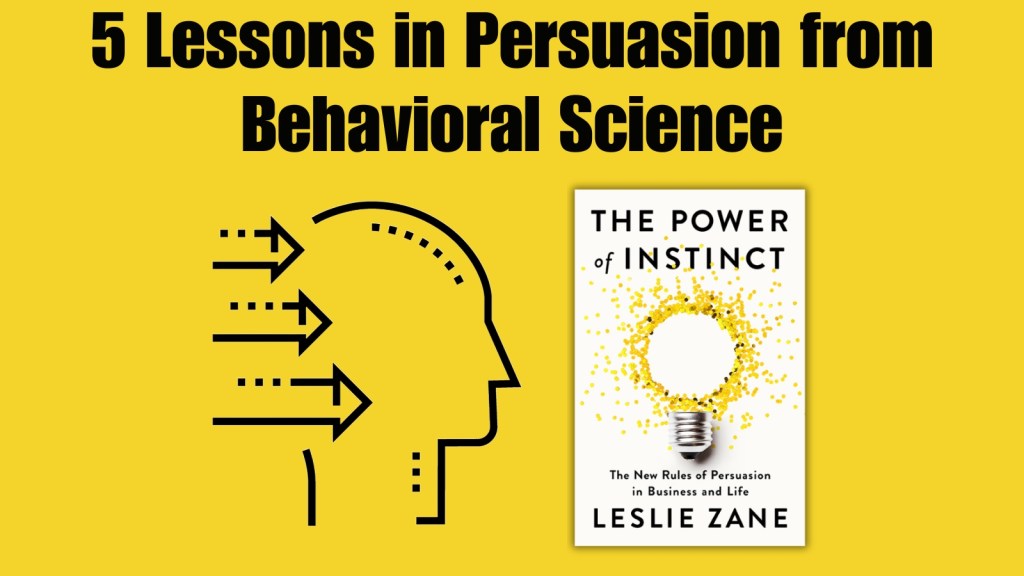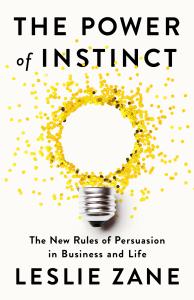5 Lessons in Persuasion from Behavioral Science
You cannot convince the conscious mind,
but you can influence the unconscious mind

In 2022, the average American saw between 4,000 and 10,000 ads per day. That’s a stunning number (and twice what you would’ve seen in 2007), and it doesn’t come cheap. That same year, brands worldwide spent $173 billion on social media ads. By 2027, it’s projected to grow to $385 billion. But is this cognitive bombardment working? Are these ads actually influencing your purchasing behavior?
Not really, says Leslie Zane, an award-winning marketer, TEDx speaker, and behavioral expert. In your conscious mind, you may believe that you make rational choices based on the information available to you, but Zane argues that it’s the opposite. You decide, and then you find a justification for your decision. “Facts don’t have the power to affect our decisions as much as we’d like to think,” says Zane in her latest book, The Power of Instinct: The New Rules of Persuasion in Business and Life. “What we are happy to believe, however, is information of any kind that confirms our world view, that which we can consciously point to when we want to prove to others, and ourselves, that we’re right.”
Instead of working against the conscious mind, Zane says, you must tap into people’s existing memories in order to influence the subconscious mind. Below, she shares five tips on how to leverage that practice to make a successful pitch, earn that raise, and win new customers.
- Take the path of least resistance by connecting with what already exists in people’s minds.
After the tragic death of Alex Trebek, the decades-long host of the TV game show Jeopardy!, Sony Pictures tried to fill the now vacant role by experimenting with a parade of celebrities, like football star Aaron Rodgers and iconic journalist Katie Couric. This trial period was a disaster. Audience ratings tanked from 6.1 in January of 2021 to 4.8 in May.
The fundamental problem was that these new hosts had nothing to do with Jeopardy! fans’ memories of the show. They went against audience’s expectations, and as the presenter changed night after night, the show’s brand further deteriorated. Instead of cramming a new host down the audience’s throat, Sony had to influence their unconscious minds with someone who felt familiar.
Enter: Ken Jennings, the record-setting former contestant who won 74 games in a row and ultimately earned $2.52 million. “When Jennings appeared as the host,” Zane writes, “existing memories about him kicked in, and viewers were automatically biased toward him.” Instead of fighting against the current, Sony leaned into it.
- Trust what people do, not what they say.
People are not reliable narrators of why they behave the way that they do. Consider this study: Participants were given the exact same piece of chocolate but in three different wrappings. Afterward, they described each one as having its own unique characteristics — despite the fact that nothing had changed.
Or consider this finding: Ask consumers what images of cheese they like best, and they’ll say the stretchy topping on a piece of gooey pizza or the melted deliciousness on the side of a burger. But change the question slightly and ask them what superior cheese looks like, and they’ll say cheese wheels, dairy farms, and happy cows.
Context, framing, and sensory clues — i.e. fodder for our unconscious mind — all matter, much more so than the rationales we give for our decisions after the fact. What this ultimately means is that the traditional tools of marketing, like polls, surveys, and focus groups, will not help you formulate your best strategies.
- To achieve instinctive brand preference, build as many connections as possible between your audience and your brand.
A brand isn’t just a product, logo, or mascot. It’s all the connections the brain has created about the brand, like the people who work at the company and the other consumers. If you can build enough associations in your audience’s minds, you will achieve instinctive brand preference, meaning that you’re people’s “go-to” choice. They’ll purchase it automatically, which is actually how we make most of our decisions. In fact, 95% of our day-to-day choices are unconscious.
Consider the success of Nike, which has more connections to more touchpoints than any other sports brand. That’s not just because of their 650 sponsorship deals across 140 leagues and organizations. It’s also because of their partnerships with international fashion brands, their exhibitions with prominent museums, and their iconic new sneaker drops.
In this way, Nike has become more than just an athletic brand. It’s also deep in our minds when it comes to art, technology, and business. For this reason, Nike has achieved instinctive brand preference, which is far superior than trying to buy your customers’ loyalty through promotions like coupons and discounts. Not only are these gimmicks expensive, but they also produce little to no long-term payoff.
- To strengthen your brand and weather market trends, nurture an ever-expanding “Connectome” of positive associations.
Based on current cultural trends, M&M’s sales should be flagging. The candy is artificially colored, artificially flavored, and hardly nutritious. And yet, M&M’s was a $990 million brand in 2021 — still growing at 7.7% per year — thanks to its robust and constantly evolving Brand Connectome.
The Connectome is all of the associations that your brand evokes, and M&M’s has nurtured these in a variety of ingenious ways. On the narrative side, the company has created an entire universe of characters that humanize the brand. While mascots are nothing new — like Kellogg’s Tony the Tiger or Energizer’s hyperactive bunny — none have the same richness as the M&M’s spokescandies.
Meanwhile, the company further cultivated positive associations in two ways. First, they introduced a range of innovations, like peanut butter M&M’s and pretzel M&M’s, that positioned the food as a snack, not just a candy. Second, they created recipes and accessories, like measuring spoons and mixing bowls, that connected the product to a whole activity: baking. This dynamic and expansive Connctome has helped the company continue thriving.
- No matter how clever, strictly emotional advertising doesn’t work.
During the 2023 Super Bowl, Quiznos aired a “Spongmonkeys” ad in which little furry creatures sang about the sandwich shops’ subs. Though the ad got some laughs, it failed to drive business. The same happened with Skittles that year. Their “Skittlepox” ad showed Skittles lovers contracting a contagious disease where the colored candies appeared on their faces. While the ad may have been noticeable at the time, it wasn’t memorable because emotions are fleeting.
One of the biggest misconceptions in marketing is the idea of “emotional advertising.” Just like you can’t force someone to love you, you can’t force them to love your brand, either. Instead, have to tap into ideas your audience cares about to break into their instinctive brain.
People don’t make decisions with their conscious mind, but on instinct. In The Power of Instinct, marketing consultant and behavioral science expert Leslie Zane shows that to grow a brand, business, or even a social movement, traditional persuasion tactics fall short. Instead, you must connect to the instinctive mind. And to do this, you need to understand the science of consumer choice and employ techniques that work with a person’s brain, not against it.
Zane uncovers the hidden network of connections that dictates the snap decisions we make and cracks the code on how to influence it. With a revolutionary set of rules for expanding the network, Zane shows us how to make any brand, business, political candidate, or idea the dominant instinctive choice. With science as your guide, as well as stories from the world’s most successful brands from McDonald’s and Lululemon to the Yankees and Taylor Swift, you’ll learn:
- What kind of messages create the greatest amount of positive associations;
- Why finding new customers accelerates growth and relying on existing ones is a trap;
- Why emotional stories are not enough to drive trial and long-term brand loyalty.
